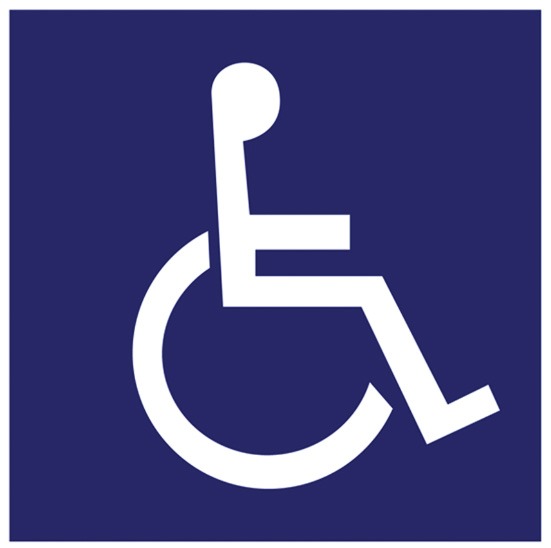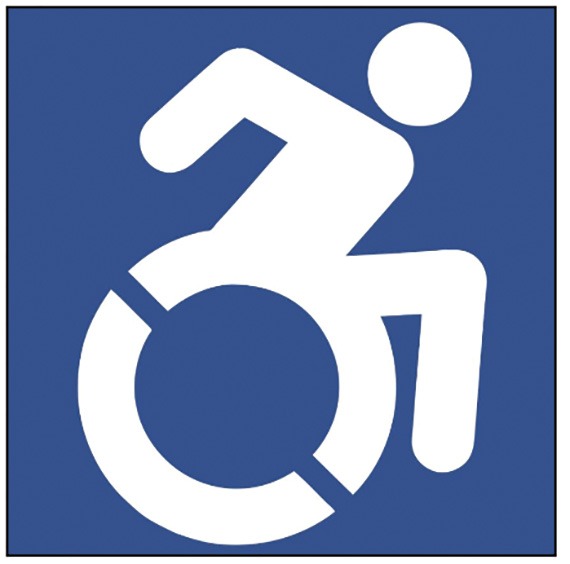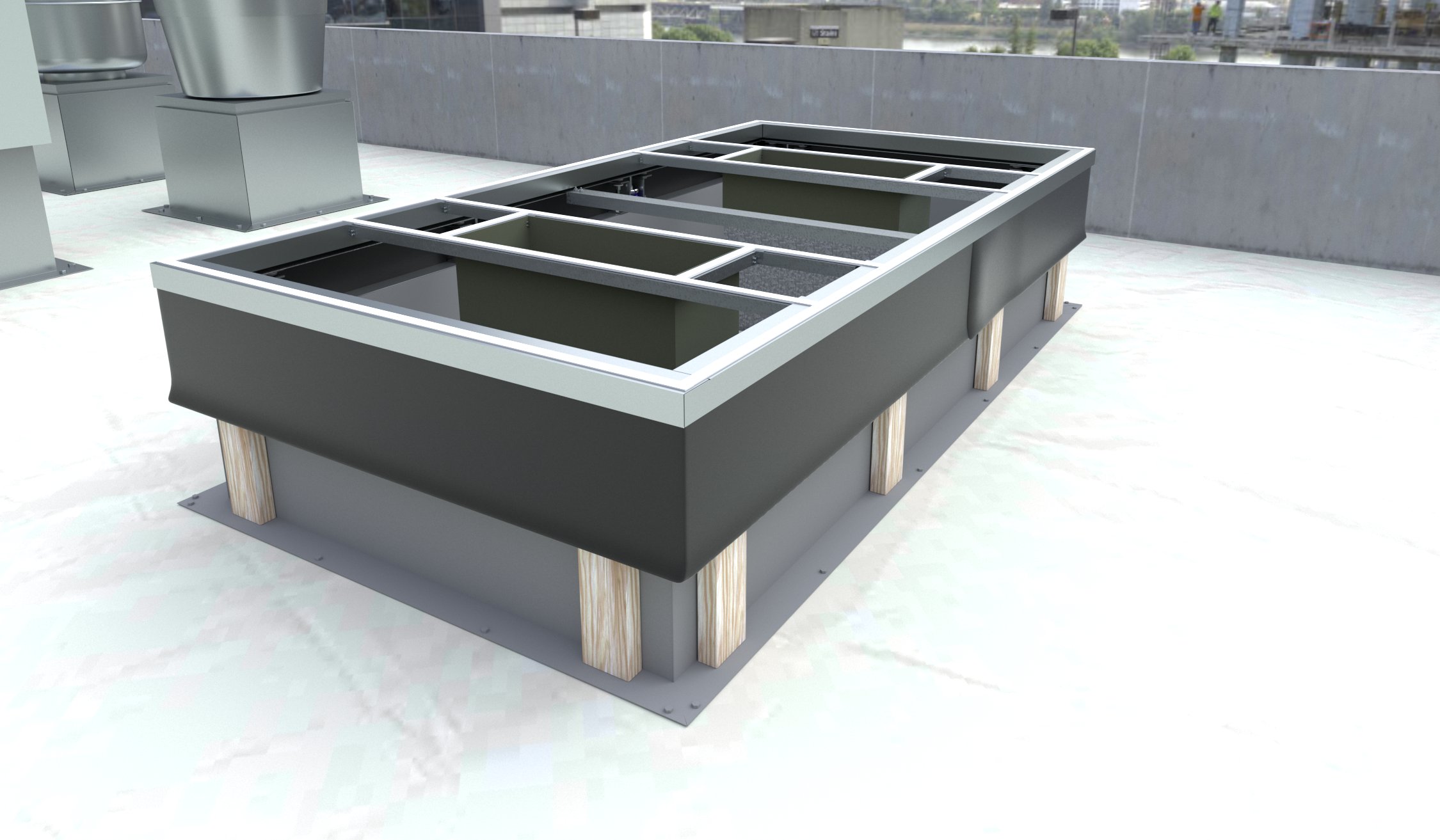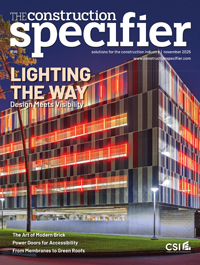Codes and standards of power-operated swinging doors

There are several codes and standards to consider when installing power-operated doors in a building. It can get complex when requirements such as accessibility and fire ratings are added. This article specifically covers the American National Standards Institute (ANSI)/Builders Hardware Manufacturers Association (BHMA) A156.10, Standard for Power Operated Pedestrian Doors, and A156.19, Standard for Power Assist and Low Energy Power Operated Swinging Doors, and the International Building Code (IBC) 2021 Edition, Chapter 11: Accessibility.
Historically, power operators have not been required by codes or standards at a national level, but this is set to change as state and local jurisdictions begin adopting the 2021 IBC, which requires at least 60 percent of all public entrances to meet the accessibility requirements. This is detailed below:
Subp. 5. IBC Section 1105, Accessible entrances
- IBC Section 1105.1, Public entrances, is amended to read as follows:
1105.1, Public entrances. In addition to accessible entrances required by Sections 1105.1.2 through 1105.1.5, at least 60 percent of all public entrances shall be accessible.
As of September 2025, the following states have adopted IBC 2021 (mostly with amendments):
Alabama, Alaska, Arkansas, California, Colorado, Connecticut, Georgia, Hawaii, Louisiana, Maine, Maryland, Massachusetts, Michigan, Montana, New Hampshire, New Jersey, New Mexico, North Carolina, North Dakota, Ohio, South Carolina, South Dakota, Tennessee, Texas, Utah, Virginia, Wisconsin, and Wyoming.
As this topic involves many specifics and technical details, excerpts from various publications have been included for clarity, addressing the following questions:
- What is IBC 2021, 1105.1.1—Automatic doors?
- How do occupancy loads impact the usage of operators?
- Which type of buildings are affected?
- What are the two main types of automatic operators?
- What are ANSI/BHMA 156.10 and 156.19?
- How are fire-rated and non-fire-rated doors managed?
- How is the required clearance calculated?
- What signage should be used?
- What special features and benefits does a power operator offer?
Table 1
TABLE 1105.1.1
Public entrance with power-operated door
| Occupancy | Building Occupant Load Greater Than |
| A-1, A-2, A-3, A-4 | 300 |
| B, M, R-1 | 500 |
In mixed-use facilities where the total sum of the building occupant load is greater than those listed, the most restrictive occupant load will apply.
2021 IBC–Standard on Automatic and Power-Assisted Doors and Gates
1105.1.1 Automatic doors. In facilities with the occupancies and building occupant loads
indicated in Table 1105.1.1, public entrances that are required to be accessible shall have one door be either a full power-operated or a low-energy power-operated door. Where the public entrance includes a vestibule, at least one door into and one door out of the vestibule shall meet the
requirements of this section.
The table lists four occupancies (Assembly [A] has four subcategories) where power-operated doors are required. This requirement applies to public entrances only, and the lists are not exhaustive. IBC defines a public entrance as an “entrance that is not a service entrance or a restricted entrance.”
- A-1—Production/performing arts/motion picture facilities such as movie theaters, concert halls, and theaters.
- A-2—Food/drink consumption facilities such as banquet halls, casinos, nightclubs, restaurants, cafeterias, taverns, and bars.
- A-3—Indoor assembly occupancies such as art galleries, bowling alleys, courtrooms, funeral parlors, indoor tennis courts, libraries, museums, places of worship, pool and billiard parlors, and waiting areas in transportation terminals.
- A-4—Indoor sporting events with spectator seating, such as arenas, skating rinks, swimming pools, and tennis courts.
- B—Business occupancies such as animal hospitals, banks, barber and beauty shops, dry cleaning, educational occupancies for students above the 12th grade, cafeterias, and similar dining facilities not more than 232 m2 (2,500 sf) in area, laboratories for testing and research, motor vehicle showrooms, post offices, print shops, professional services (architects, attorneys, dentists, physicians, engineers), TV/radio stations, tutoring centers, martial arts studios, and gymnastic studios.
- M—Mercantile occupancies that display and sell merchandise where the public has access, such as department stores, drug stores, markets, greenhouses with public access, motor fuel-dispensing facilities, retail stores, and sales rooms.
- R-1—Hotel occupancies of transient nature, such as boarding houses with more than 10 occupants, congregate living facilities with more than 10 occupants, hotels, and motels.

A-1, A-2, A-3, and A-4 assembly occupancies with an entire building occupant load of 300 people or more are required to have accessible public entrances with at least one fully power-operated door or one set of power-operated doors (the exterior and vestibule). Business, mercantile, and R-1 occupancies with an entire building occupant load of 500 people or more are required to have the same.
When doors are required to be power-operated, the IBC references ICC A117.1, 2017 Edition, Standard for Accessible and Usable Building and Facilities, and it states:
404.3.1 Public entrances.
Where an automatic door or gate is required at a building or facility public entrance, it shall be a full powered automatic or a low-energy automatic door or gate.
404.3.2 Vestibules.
Where an entrance includes a vestibule, at least one exterior door or gate and one interior door or gate in the vestibule shall have the same type of automatic door or gate opener.
These two statements clarify that power-assisted doors are not to be used to comply with an automatic operator requirement (because they require manual operation). If an automatic operator is required, for whatever reason, only a fully power-operated door or low-energy door can be used. This is further explained in the commentary version of the standard.
Only if a project is required to comply with 2021 IBC and a public entrance is required to be accessible, the use group is one of those listed above, and the occupant load is greater than 300 or 500 (depending on the group), then it must comply with this new automatic operator requirement.
Now that the IBC 2021 Edition requires power-operated doors, let’s look at the two main types to understand how to choose the correct operation for the application.

Two main types of power-operated doors
High-energy power-operated doors
Fully automatic doors, also referred to as high-energy, often use a sensor to start the opening cycle of the doors. This sensor can be a motion-type device, mounted over the door opening or a floor mat with a built-in switch, which is activated when someone approaches the opening. The user does not have to think about how to open the door. Instead, they step into the activation field of the motion sensor, and the doors automatically open, allowing the user to enter or exit the building. Door openings with fully automatic doors are often found in large retail and grocery stores.
“This type of power-operated opening will require sensors to ensure that the door does not create a hazard to persons standing in the path of travel of the door,” says James Stokes, director of corporate training, Hager Companies. “Guide rails, safety mats, presence sensors, or other safety devices must be mounted around these doors to prevent accidents.”
A “knowing act” switch can be used, but due to the opening speed and force, added safety sensors would be required. In addition, certified installers must install and service these operators to ensure that the safety sensors, mats, and other products are calibrated and all the codes and standards are followed.
Low-energy power-operated doors and power-assisted doors
Low-energy doors are not subject to such strict requirements due to their slower opening speed and lower opening force. Door initiation is another key factor, as they do not open without a specific act to set them in motion, which is referred to as a “knowing act.”
- ANSI/BHMA A156.19-2019—1.1 Requirements in this standard apply only to swing door operators. The operator types are power assist and low-energy power operators for pedestrian use and some small vehicular use. It does not address doors, finishes, or hardware. The activation of all doors described in this standard requires a knowing act. Included are provisions intended to reduce the chance of user injury or entrapment. These products are intended to improve accessibility.
- ANSI/BHMA 156.19-2019—4.1 Activation: The operator shall be activated by a knowing act.
There are many options that can be used as “a knowing act.” The 2019 edition of ANSI/BHMA A156.19 defines a knowing act as:
Any conscious action with the expected result of opening a door. This includes but is not limited to: wall or jamb-mounted contact switches such as push plates; the action of manual opening (pushing or pulling) a door; and controlled access devices such as keypads, card readers, wireless transmitters and key switches.
To further explain this definition, look at this in application. The remote switch (sometimes placed in a post or bollard on the exterior) or jamb-mounted switch (mounted directly onto the frame) is usually labeled with a wheelchair symbol or text that may read “push to open.” This switch is depressed to open the door. COVID-19 brought forth the need for contactless switch options, also considered a knowing act switch. These have a short-range motion sensor so that a hand directly in front of it, without actual physical contact, activates the switch and opens the door.
Where an access-controlled door is always closed and in the locked position, a valid credential presented to a reader can be used to unlock the door and signal the low-energy operator to open the door. This also qualifies as a knowing act.
Another option is referred to as “power-assist” or “push-and-go.” A user sets the door in motion, and then the low-energy operator takes over to complete the opening cycle. Examples of these opening types can be found in many facilities, including schools, hospitals, office buildings, and public restrooms.
Additionally, the A156.19 4.2 standard recommends the mounting location of a knowing act switch. Actuation switches should be located:
- A maximum of 3.7 m (12 ft) from the center of the door (0.3 to 1.5 m [1 to 5 ft] is preferred)—when further, the recommended increased hold-open time is one additional second per 0.3 m
(1 ft) of distance: - Where the switch remains accessible when the door is opened, and the user can see the door when activating the switch.
- In a location where the user would not be in the path of the moving door; and at an installation height of 864 mm (34 in.) minimum and 1,219 mm (48 in.) maximum above the floor.
Geographical specifics of knowing act switches
As noted at the beginning of this article, specifying the correct hardware can become complex when multiple requirements, such as accessibility and fire ratings, are added. However, the differences between national, state, and local codes also need to be considered.
For example, while ANSI/BHMA A156.19 only requires one actuator, the California Building Code (CBC) requires two push plate actuators. One is mounted between 178 mm (7 in.) minimum and 203 (8 in.) maximum from the floor or ground surface to the centerline of the switch, and the second is mounted between 762 mm (30 in.) minimum and 1,118 mm (44 in.) maximum above the floor to the centerline of the switch. The CBC allows vertical actuation bars to be used in place of two separate actuators. However, the operable portion of the bar must be mounted, “so the bottom is 5 inches (127 mm) maximum above the floor or ground surface, and the top is 35 inches (889 mm) minimum above the floor or ground surface.” The bar must also be a minimum of 51 mm (2 in.) wide.

Opening and closing speeds and hold-open timings
ANSI/BHMA A156.19
4.3 Opening: Doors shall open from closed to back check, or 80 degrees whichever occurs first, in 3 seconds or longer as required in Table 1. Backcheck shall not occur before 60 degrees. Total opening time to 90 degrees shall be as in Table II. If the door opens more than 90 degrees, it shall continue at the same rate as backcheck speed.
4.4 Time Delay: When powered open, the door shall remain at the fully open position for not
less than 5 seconds. Exception: When push-pull activation is used, the door shall remain at the fully open position for not less than 3 seconds.
4.5 Closing: Doors shall close from 90 degrees to 10 degrees in 3 seconds or longer as required in Table 1. Doors shall close from 10 degrees to fully closed in not less than 1.5 seconds.
Due to slower opening and closing speeds, built-in safety features, and knowing act switches, power-assist doors and low-energy doors do not require any additional safety sensors.
Power-operated doors and maneuvering requirements
Generally, a power-operated or low-energy door is not required to meet maneuvering clearance requirements for entry. However, if the door is being used to meet accessible means of egress, maneuvering clearance is required in case it loses power. Maneuvering clearance requirements can be exempted if loss of power is addressed with battery backup, if doors remain in the open position upon loss of power, or if a break-away feature is included. Power-assist doors, on the other hand, require maneuvering clearances.
ICC A117.1
404.3.3 Clear width.
Doorways shall have a clear opening width of 32 inches (815 mm) in power-on and power-off mode. The minimum clear opening width for automatic door systems shall be based on the clear opening width provided with all leaves in the open position.
404.3.4 Maneuvering clearances.
Maneuvering clearances at power-assisted doors and gates shall comply with Section 404.2.3. Maneuvering clearances complying with Section 404.2.3 shall be provided on the egress side of low-energy automatic and full power automatic doors and gates that serve as part of an
accessible means of egress.
404.2.3 Maneuvering clearances.
Minimum maneuvering clearances at doors and gates shall comply with Section 404.2.3. Maneuvering clearances shall include the full clear opening width of the doorway and the required latch-side or hinge-side clearance.

Signage
Doors complying with ANSI/BHMA A156.10-2017 section 11 signage “shall be equipped with signage visible from both sides reading ‘AUTOMATIC DOOR’ with letters 13 mm (0.5 in.) high minimum.” There are also additional signage requirements depending on specific applications.
ANSI/BHMA A156.19-2019, chapter 6, requires signage on both sides of the opening that clearly instructs the user about the door’s operation and function. The lettering must be a minimum of
16 mm (0.625 in.) high, and the signs must be mounted 1,270 mm (50 in.) ±305 mm (12 in.) from the floor to the sign’s center line.
Power assist doors (6.3) using a separate wall switch require signage noting “Easy Open Door—Activate Switch Then Open Door.” The standard even states that the “lettering shall be white, and the background shall be blue.”
Low-energy doors (6.4) states, “All low energy doors shall be marked with signage visible from both sides of the door with the words ‘CAUTION AUTOMATIC DOOR’ and include the sign requirements.” Additional requirements are also added for knowing act switches and push/pull doors.
The traditional handicapped wheelchair sign has been updated to show a more dynamic, forward-moving image. New York and Connecticut have already adopted this new symbol.
Variations when fire codes are required
When power-operated doors are fire-rated, they must be equipped with a device that automatically releases, thus disconnecting the power to the operator at the time of fire. This allows the doors to self-close and positively latch.
Push and pull plates on doors
Openings with push-and-pull bars or plates do not have latches to keep the door shut or prevent the opener from working, so they can be activated at all times and allow the operator to work easily.
Exit devices can have the latches mechanically retracted (dogging the device). Dogging doors makes this basically a push/pull type of door. This is often done at the main entrance of a public space, such as the lobby of an office or a retail space. During business hours, the doors are unlocked and can be used manually or by pressing the actuator to open the door. In this scenario, though, when the door is latched, the operator should be turned off or disabled. This is often done with a key switch to interrupt the circuit from the actuator to the operator, thus eliminating damage that occurs when an operator tries to open the door and is not able to because of the latch being engaged.
Electrified and latch retraction locking devices
Electrifying the locking device can provide more options and flexibility. With this, the door can be used even when it is latched and/or locked.
Brian Clarke, director of specifications, Hager Companies, notes, “This is a better solution for exterior openings as these doors often have HVAC pressures or wind conditions that can push or pull the door open when it is not latched.”
This also allows the inside button to be active at all times (even when the door is locked), and then a key switch, timer, or access control system is used to disable the outside button when the door is locked to allow for security. With an access control system or a timer, the doors can be set to lock and unlock on a programmed schedule. This provides greater security and allows the operator to be used after business hours to exit the building.
Sequencing
There are times when an exterior and vestibule door are desired to work together, allowing a person to press one button and have both doors in the series open, rather than individual presses of a button for each. This would be the same for exiting. This sequencing is done either through the logic boards in the operator or a relay board called a sequencer. It is a desirable feature for areas that have individuals with physical difficulties or where deliveries occur, to allow easier use of the openings. Some examples include physical rehabilitation clinics, assisted living facilities, and entrances leading to package rooms or bicycle storage areas.
Barrier-free restrooms
These are not currently required by code in the U.S., but could be soon. Canada now requires these systems to be installed in public buildings. Special relay boards are used to create a specific operation. A user presses an actuator, located outside the restroom, which activates the automatic opener. If there is someone already using the facility, the door will remain closed. Once in the restroom, there is either an electrified lock or strike that is activated by a push button inside the restroom. This button will have a visual indicator or lettering that states “push to lock.” This button signals to the relay board that the room is in use, thus locking the electrified locking device and disabling the operator, preventing others from entering from the outside. This feature is automatically reset when the door is opened (generally by a door position switch, a request to exit switch, or activation by an inside button of the operator), allowing other users to enter.
Smoke evacuation functions
There are situations where a large atrium is required to have a smoke evacuation system. For the system to get enough airflow to work properly, the outside doors must automatically open and stay open to allow airflow. Operators can be used in this situation. They would be activated by the smoke detection system and open these doors. When fully opened, the doors would then send a signal to the smoke evacuation system, allowing the necessary fans to be activated.
Conclusion
The adoption of IBC 2021 Chapter 11 has had, and will continue to have, a significant impact on the embracement of automatic operators. With the many new features available with relay boards and selective programming, low-energy automatic operators can not only fulfill the remits of accessibility but also offer extensive convenience and security benefits for building owners and users.
Always be sure to consult with your Authority Having Jurisdiction (AHJ) when designing a system involving automatic operators to ensure your solution meets their expectations and the local codes.
Author
Kevin Tish, AOC, CFDAI, DHC, DHT, CDT, has been involved in many aspects of the building industry. He is currently the manager of the Architectural Specification Writers. He has credentials from both the Construction Specifications Institute (CSI) and Door and Hardware Institute (DHI). He may be reached at ktish@hagerco.com.
Key Takeaways
The 2021 International Building Code (IBC) introduces major accessibility requirements, mandating power-operated doors at 60 percent of public entrances in many occupancies. Compliance involves navigating ANSI/BHMA A156.10 and A156.19 standards, occupancy thresholds, and safety features. Understanding distinctions between high-energy and low-energy operators, signage, fire code implications, and local amendments is essential for proper specification and code alignment.










